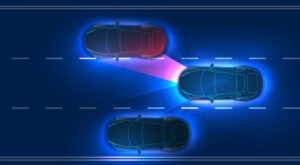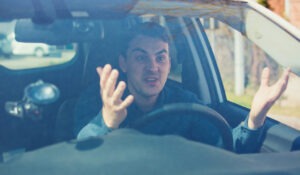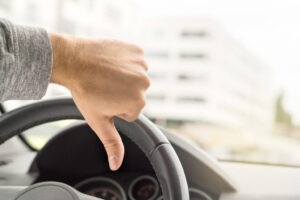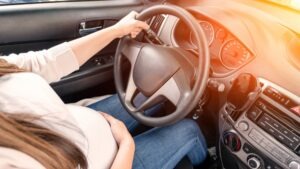
Roughly 3,112 people in Florida were killed in car collisions during 2017, according to the National Highway Transportation Safety Administration (NHTSA), versus 37,133 people killed in the entire U.S. Florida’s rate of deadly traffic accidents per 100,000 population is 14.83, much higher than the overall U.S. rate of 11.40. There were 166,628 crashes in which someone was injured in Florida last year, according to Florida Highway Safety and Motor Vehicles.
Car accidents stem from all kinds of causes and can occur for all types of reasons. But one of the most potentially frightening is the sideswipe collision. Not only that, but across the U.S., sideswipes are responsible for 2.7 percent of fatal crashes, according to the Insurance Information Institute. To learn more about sideswipe accidents Read on, to understand your legal options after and accident speak with an experienced auto injury attorney.
1. What Is a Sideswipe Collision?
A sideswipe collision is exactly what it sounds like: one vehicle swipes the side of another vehicle that is going in the same direction. It is not a T-bone, head-on, or rear-end collision, all of which involve cars going in different directions.
A sideswipe collision can be a minor incident, in which Car A barely grazes Car B. But it can also be a collision with much more force, depending on how close the cars are, how much of the surface of each car is affected, how much of an impact they have, and the speed each is going.
At their worst, sideswipes can either knock one or each car out of their lane. If that occurs, the cars can hit other vehicles, objects like guardrails, or go off the road entirely. The cars can be sent in lanes of opposite traffic or across dividers. Drivers rarely see sideswipes coming, so they are surprised and caught unprepared. The force or noise may cause panic, so the drivers can’t or don’t steer out of any impact. They may lose control of the car even when the impact alone wouldn’t cause loss of control.
As a result, sideswipes can end up as catastrophic, multi-vehicle accidents in which motorists are seriously hurt or even killed.

Expect More, Receive More: Legal Support That Feels Like Family
2. Why Do Sideswipe Collisions Happen?
The key reason is that one car has moved out of a lane when they shouldn’t have, because another car was either in the lane they changed to or shortly arrived there. Sideswipes are most commonly caused by cars on the right side sideswiping the left side of another vehicle, but in multi-lane traffic, cars on the left can also sideswipe cars on the right.
Unfortunately, the precipitating reason a sideswipe collision happens is almost always driver error, although manufacturing error, weather, and road conditions can also play a part.
3. What Are the Reasons Sideswipe Collisions Occur?
Distracted Driving
Distracted driving can occur for many reasons—anything that causes a driver to take attention from the road and the task of driving. It is not always related to use of cellphones or other electronic devices. Daydreaming about an upcoming vacation or even searching for a music CD can distract a driver enough to drift into another lane—and to not notice another car is there.
Driving Under the Influence
Drivers who are under the influence of alcohol or other substances can display poor judgment or not be fully aware of their surroundings. As a result, they may be prone to not notice the position of other cars, attempt to change lanes without checking, or drift or weave between lanes—all things that can cause a sideswipe.
Road Rage or Aggressive Driving
Road rage is extremely aggressive driving in which people feel they are being held up by other drivers. Aggressive driving is unsafe driving for the circumstances and environment. Both can cause drivers to attempt to weave or dart in and out of lanes, often at fast and reckless speeds.
Failure to Signal
Drivers changing lanes should signal their intent in plenty of time. If they don’t, another car may get into the lane they are trying to change into, or speed up or slow down so that they are side by side a vehicle attempting to change lanes without being aware of the impending lane change.
Merging into the Same Lane
Drivers can also inadvertently merge into the same lane from different lanes. On a three-lane or more highway, for example, drivers in both the right lane and left lane could decide to change into the middle lane. If they aren’t paying attention to traffic, a sideswipe can result.
Merging Without Checking the Lane
Sideswipe collisions can happen if a driver merges into a lane of traffic without checking that lane’s traffic at all. Drivers should always look to see if any other vehicles are in the lane.
Not Checking Blind Spots
Despite the placement of rear- and side-view mirrors, all cars and drivers have blind spots. Sometimes, drivers change lanes without sufficiently checking the blind spots.
Road Conditions
Although it may be rare, some road conditions can cause a sideswipe. Improperly marked and flagged detour lanes, construction, and deep potholes can also cause drivers to be jarred into lanes, to not realize they are changing lanes, or to not see lanes appropriately.
Weather
Weather conditions can cause sideswipe collisions. Extremely wet conditions can cause a car to hydroplane. Gusty winds can make it difficult for cars to stay in lanes appropriately.
Manufacturing or Mechanical Error
In some cases, mechanical error may make a driver unable to control a car or may cause conditions that cause a car to go into another lane.
Improper Maintenance
Improper maintenance can cause a car’s safety features, such as turn signals or brakes, to not operate properly. These and other issues caused by poor maintenance can cause a sideswipe.
4. What Should I Do If I’m Sideswiped?
If you are in a sideswipe collision, act to preserve your own safety and that of your loved ones.
First, attempt to stay calm and keep control of your car. Try to regain control if you momentarily lost it. Don’t jerk the wheel to either side; that can exacerbate any spin or abrupt move into other lanes, which can also be dangerous. Don’t slam on the brakes either. Slow down gradually and pull off the road as soon as you can, so you’ve not in traffic.
Once you are safe, take the steps you need to take in any accident. If you or anyone else needs immediate medical attention, call 911. Then, call the police to report the accident.
Florida law requires motorists to report all accidents that cause injury or death, or property damage of $500 or more. (If you aren’t sure what the dollar amount is, err on the safe side.) You should call the local police if you are in a municipality, or the county sheriff, or the Florida Highway Patrol.
The police report is not only required by law, it will provide you with information for the insurance company. Police reports note what happened, where it happened, the extent of damage or injuries, and more. If another party is at fault, and you want to pursue the matter to be justly compensated for damages, a police report provides valuable evidence for the case.
Take pictures of the accident scene, your injuries, and any damage to your car. Investigators can tell a great deal about the causes of an accident by the amount and position of damage, the trajectory, and any other objects (cars, guardrails, and so on) that were impacted.
If possible, interview any witnesses as well. Witnesses can also help determine the causes of the accident and the responsibility for it.
The other driver(s) should all either have stopped as close as possible or returned after pulling over. Leaving the scene of any car accident is illegal in Florida; it’s known as a hit and run. Drivers involved need to exchange their names, addresses, and driver’s licenses and registration information.
You may well be very upset. All accidents are upsetting, and surprise sideswipes among the most frightening. Be sure to remain calm and let the authorities deal with the accident.
5. What If I’m Injured in a Sideswipe Collision?
If you know you are injured (for example, pain, loss of feeling or motion, are bleeding, and so on), either call 911 or visit an emergency room immediately. Safety comes first.
Even if you don’t feel any injury, it’s a very good idea to see a physician as soon as possible after an accident. Many injuries, such as concussions, do not manifest with symptoms the victim can necessarily feel. Many more, such as damage to soft tissue, can manifest later, after some time has gone by. A physician can diagnose any problems or reassure you.
Be sure to save all records of any healthcare visits related to the accident, those from including doctor’s offices, emergency rooms, pharmacies, hospitals, physical therapy, and so on.
Injuries in car accidents are usually covered under Florida’s no-fault insurance rules. Medical bills related to injuries sustained in the accident are covered by your own insurance company. Florida law requires motorists to have $10,000 in personal injury protection (PIP), which is designed to compensate injured parties for monetary damages, like doctor and hospital bills and lost wages from work, if your injuries have caused you to miss work. Motorists are also required to have $10,000 in property damage liability (PDL) for vehicle or other property damages related to an accident.
If you or a loved one are severely injured, however, you may have the right to seek compensation beyond from the at-fault party’s insurance and/or through a personal injury suit.
The law defines severe injury as
- Significant disfigurement
- Bone fracture
- Permanent limitation of use of a body member or organ
- Significant limitation of use of a body function or system
- Any injury that causes substantially full disability for 90 days
If any of these have occurred, you can claim noneconomic damages like pain and suffering, which usually aren’t covered under the no-fault insurance requirement.
6. What Determines Fault in an Accident?
In seeking compensation from someone other than your own no-fault carrier, you must have reason to believe the party you seek compensation from was at fault.
If another driver’s actions caused the accident, they can be deemed negligent. All drivers are responsible for obeying the law and practicing safe driving. Failure to signal or to check blind spots, driving under the influence of alcohol, speeding, and reckless driving—in short, all the driver errors that can underlie a sideswipe accident—typically constitute violations of the duty of care required of all drivers as part of their driving responsibility. If negligence caused an accident, and the accident caused injuries, victims can hold the negligent driver responsible.
Similarly, if roadway conditions or manufacturer’s defects were the cause of the accident, the parties responsible for those conditions or defects might be held liable.
7. What if They Say I’m Responsible?
Insurance companies and defendants in personal injury suits often try to pay the lowest amount of damages possible or deny responsibility for the sideswipe. Even if you say something like “I’m so sorry” after an accident, the insurance company or the other party may try to argue that the statement means you are responsible. (Never say anything like this!)
For example, if a sideswipe collision was caused by two cars entering a lane at the same time. Even if you checked thoroughly, the other driver can try to argue that you are responsible.
Hire an experienced attorney to thoroughly investigate the causes of an accident. Seasoned lawyers can negotiate with insurance companies and argue for justice in court, if necessary.
If you need further information or assistance about a sideswipe accident, contact a licensed car accident lawyer.
Viles & Beckman, LLC
6350 Presidential Court
Fort Myers, FL 33919
T: (239) 334-3933






